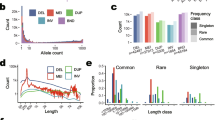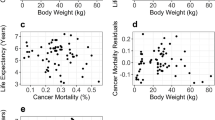Abstract
Background and aim
Mortality is a highly complex trait influenced by a wide array of genetic factors.
Methods
We examined a population of 1200 mice that were F2 generation offspring of a 4-way reciprocal cross between C57BL6/J and DBA2/J strains. Animals were sacrificed at age 200, 500, or 800 days and genotyped at 96 markers. The 800 days old cohort, which were the survivors of a much larger breeding group, were examined for enriched frequency of alleles that benefit survival and depletion of alleles that reduce survival.
Results
Loci on Chr 13 in males and on Chr X in females were significantly distorted from Mendelian expectations, even after conservative correction for multiple testing. DBA2/J alleles between 35 and 80 Mb on Chr 13 were underrepresented in the age 800 male animals. D2 genotypes in this region were also associated with premature death during behavioral testing. Furthermore, confirmatory analysis showed BXD recombinant inbred strains carrying the D2 alleles in this region had shorter median survival. Exploration of available pathology data indicated that a syndrome involving dental malocclusions, pancreatic islet hypertrophy, and kidney lipidosis may have mediated the effects of DBA alleles on mortality specifically in male mice. The heterozygote advantage locus on the X Chr was not found to be associated with any pathology.
Conclusions
These results suggest a novel locus influencing survival in the B6/D2 genetic background, perhaps via a metabolic disorder that emerges by 200 days of age in male animals.



Similar content being viewed by others
References
Herskind AM, McGue M, Holm NV et al (1996) The heritability of human longevity: a population-based study of 2872 Danish twin pairs born 1870–1900. Hum Genet 97(3):319–323
Miller RA (1999) Kleemeier award lecture: are there genes for aging? J Gerontol A Biol Sci Med Sci 54(7):B297–B307
Willcox BJ, Donlon TA, He Q et al (2008) FOXO3A genotype is strongly associated with human longevity. Proc Natl Acad Sci USA 105(37):13987–13992. doi:10.1073/pnas.0801030105
Anselmi CV, Malovini A, Roncarati R et al (2009) Association of the FOXO3A locus with extreme longevity in a southern Italian centenarian study. Rejuvenation Res 12(2):95–104. doi:10.1089/rej.2008.0827
Flachsbart F, Caliebe A, Kleindorp R et al (2009) Association of FOXO3A variation with human longevity confirmed in German centenarians. Proc Natl Acad Sci USA 106(8):2700–2705. doi:10.1073/pnas.0809594106
Li Y, Wang WJ, Cao H et al (2009) Genetic association of FOXO1A and FOXO3A with longevity trait in Han Chinese populations. Hum Mol Genet 18(24):4897–4904. doi:10.1093/hmg/ddp459
Soerensen M, Dato S, Christensen K et al (2010) Replication of an association of variation in the FOXO3A gene with human longevity using both case-control and longitudinal data. Aging Cell 9(6):1010–1017. doi:10.1111/j.1474-9726.2010.00627.x
Newman AB, Murabito JM (2013) The epidemiology of longevity and exceptional survival. Epidemiol Rev [Epub ahead of print]
Leduc MS, Hageman RS, Meng Q et al (2010) Identification of genetic determinants of IGF-1 levels and longevity among mouse inbred strains. Aging Cell 9(5):823–836. doi:10.1111/j.1474-9726.2010.00612.x
Lang DH, Gerhard GS, Griffith JW et al (2010) Quantitative trait loci (QTL) analysis of longevity in C57BL/6J by DBA/2J (BXD) recombinant inbred mice. Aging Clin Exp Res 22(1):8–19
Gelman R, Watson A, Bronson R et al (1988) Murine chromosomal regions correlated with longevity. Genetics 118(4):693–704
Jackson AU, Galecki AT, Burke DT et al (2002) Mouse loci associated with life span exhibit sex-specific and epistatic effects. J Gerontol A Biol Sci Med Sci 57(1):B9–B15
Foreman JE, Lionikas A, Lang DH et al (2009) Genetic architecture for hole-board behaviors across substantial time intervals in young, middle-aged and old mice. Genes Brain Behav 8(7):714–727. doi:10.1111/j.1601-183X.2009.00516.x
Lang DH, Conroy DE, Lionikas A et al (2009) Bone, muscle, and physical activity: structural equation modeling of relationships and genetic influence with age. J Bone Miner Res 24(9):1608–1617. doi:10.1359/jbmr.090418
Blizard DA, Lionikas A, Vandenbergh DJ et al (2009) Blood pressure and heart rate QTL in mice of the B6/D2 lineage: sex differences and environmental influences. Physiol Genomics 36(3):158–166. doi:10.1152/physiolgenomics.00035.2008
Johannes F, Blizard DA, Lionikas A et al (2006) QTL influencing baseline hematocrit in the C57BL/6J and DBA/2J lineage: age-related effects. Mamm Genome 17(6):689–699
Foreman JE, Blizard DA, Gerhard G et al (2005) Serum alkaline phosphatase activity is regulated by a chromosomal region containing the alkaline phosphatase 2 gene (Akp2) in C57BL/6J and DBA/2J mice. Physiol Genomics 23(3):295–303
Wang J, Williams RW, Manly KF (2003) WebQTL: web-based complex trait analysis. Neuroinformatics 1(4):299–308
Murabito JM, Yuan R, Lunetta KL (2012) The search for longevity and healthy aging genes: insights from epidemiological studies and samples of long-lived individuals. J Gerontol A Biol Sci Med Sci 67(5):470–479. doi:10.1093/gerona/gls089
Nuzhdin SV, Pasyukova EG, Dilda CL et al (1997) Sex-specific quantitative trait loci affecting longevity in Drosophila melanogaster. Proc Natl Acad Sci USA 94(18):9734–9739
Gems D, Riddle DL (2000) Genetic, behavioral and environmental determinants of male longevity in Caenorhabditis elegans. Genetics 154(4):1597–1610
Henckaerts E, Langer JC, Snoeck HW (2004) Quantitative genetic variation in the hematopoietic stem cell and progenitor cell compartment and in lifespan are closely linked at multiple loci in BXD recombinant inbred mice. Blood 104(2):374–379
Wang Q, Jin T (2009) The role of insulin signaling in the development of β-cell dysfunction and diabetes. Islets 1(2):95–101. doi:10.4161/isl.1.2.9263
Fuller JL, Cooper CW (1967) Saccharin reverses the effect of food deprivation upon fluid intake in mice. Anim Behav 15(4):403–408
Schreiber RA, Ungar AL (1984) Glucose protects DBA/2J mice from audiogenic seizures: correlation with brain glycogen levels. Psychopharmacology 84(1):128–131
Hummel KP, Coleman DL, Lane PW (1972) The influence of genetic background on expression of mutations at the diabetes locus in the mouse. I. C57BL-KsJ and C57BL-6J strains. Biochem Genet 7(1):1–13
Coleman DL (1981) Inherited obesity-diabetes syndromes in the mouse. Prog Clin Biol Res 45:145–158
Anderson AA, Helmering J, Juan T et al (2009) Pancreatic islet expression profiling in diabetes-prone C57BLKS/J mice reveals transcriptional differences contributed by DBA loci, including Plagl1 and Nnt. Pathogenetics 2(1):1. doi:10.1186/1755-8417-2-1
Clee SM, Attie AD (2007) The genetic landscape of type 2 diabetes in mice. Endocr Rev 28(1):48–83
Mu JL, Naggert JK, Svenson KL et al (1999) Quantitative trait loci analysis for the differences in susceptibility to atherosclerosis and diabetes between inbred mouse strains C57BL/6J and C57BLKS/J. J Lipid Res 40(7):1328–1335
Togawa K, Moritani M, Yaguchi H et al (2006) Multidimensional genome scans identify the combinations of genetic loci linked to diabetes-related phenotypes. Hum Mol Genet 15:113–128
Weiss LA, Pan L, Abney M et al (2006) The sex-specific genetic architecture of quantitative traits in humans. Nat Genet 38(2):218–222
Doria A, Patti ME, Kahn CR (2008) The emerging genetic architecture of type 2 diabetes. Cell Metab 8(3):186–200. doi:10.1016/j.cmet.2008.08.006
Blake JA, Bult CJ, Eppig JT et al (2014) The Mouse Genome Database: integration of and access to knowledge about the laboratory mouse. Nucleic Acids Res 42(D1):D810–D817
Rasche A, Al-Hasani H, Herwig R (2008) Meta-analysis approach identifies candidate genes and associated molecular networks for type-2 diabetes mellitus. BMC Genomics 9:310. doi:10.1186/1471-2164-9-310
Toye AA, Lippiat JD, Proks P et al (2005) Agenetic and physiological study of impaired glucose homeostasis control in C57BL/6J mice. Diabetologia 48(4):675–686
Aston-Mourney K, Wong N et al (2007) Increased nicotinamide nucleotide transhydrogenase levels predispose to insulin hypersecretion in a mouse strain susceptible to diabetes. Diabetologia 50(12):2476–2485
Wong N, Blair AR, Morahan G et al (2010) The deletion variant of nicotinamide nucleotide transhydrogenase (Nnt) does not affect insulin secretion or glucose tolerance. Endocrinology 151(1):96–102. doi:10.1210/en.2009-0887
Kido Y, Philippe N, Schäffer AA et al (2000) Genetic modifiers of the insulin resistance phenotype in mice. Diabetes 49(4):589–596
Kilimnik G, Kim A, Steiner DF et al (2010) Intraislet production of GLP-1 by activation of prohormone convertase 1/3 in pancreatic α-cells in mouse models of ß-cell regeneration. Islets. 2(3):149–155
Strawbridge RJ, Dupuis J, Prokopenko I et al (2011) Genome-wide association identifies nine common variants associated with fasting proinsulin levels and provides new insights into the pathophysiology of type 2 diabetes. Diabetes 60(10):2624–2634. doi:10.2337/db11-0415
Manning AK, Hivert MF, Scott RA et al (2012) A genome-wide approach accounting for body mass index identifies genetic variants influencing fasting glycemic traits and insulin resistance. Nat Genet 44(6):659–669. doi:10.1038/ng.2274
Liu S, Mauvais-Jarvis F (2010) Minireview: Estrogenic protection of beta-cell failure in metabolic diseases. Endocrinology 151(3):859–864. doi:10.1210/en.2009-1107
Oh YS, Khil LY, Cho KA et al (2008) A potential role for skeletal muscle caveolin-1 as an insulin sensitivity modulator in ageing-dependent non-obese type 2 diabetes: studies in a new mouse model. Diabetologia 51(6):1025–1034. doi:10.1007/s00125-008-0993-0
Oh YS, Lee TS, Cheon GJ et al (2011) Modulation of insulin sensitivity and caveolin-1 expression by orchidectomy in a nonobese type 2 diabetes animal model. Mol Med 17(1–2):4–11. doi:10.2119/molmed.2009.00105
Petznek H, Kappler R, Scherthan H et al (2002) Reduced body growth and excessive incisor length in insertional mutants mapping to mouse Chromosome 13. Mamm Genome 13(9):504–509
Chávarry NG, Vettore MV, Sansone C et al (2009) The relationship between diabetes mellitus and destructive periodontal disease: a meta-analysis. Oral Health Prev Dent 7(2):107–127
Santacroce L, Carlaio RG, Bottalico L (2010) Does it make sense that diabetes is reciprocally associated with periodontal disease? Endocr Metab Immune Disord Drug Targets 10(1):57–70
Saremi A, Nelson RG, Tulloch-Reid M et al (2005) Periodontal disease and mortality in type 2 diabetes. Diabetes Care 28(1):27–32
Acknowledgments
We acknowledge the encouragement of Jerry McClearn Principal Investigator on P01-AG-14731 which supported this research. T32-AG-00276 provided stipends for graduate students. Jeanne Spicer provided superb database management. Thanks to Susan E. Lingenfelter, Kim A. Seymour, David A. Bienus, Gee-Sue Park, and Olivia Nourie for their excellent technical assistance and writing support.
Conflict of interest
All authors declare we have no financial conflicts of interest.
Human and Animal Rights
All animals were maintained according to protocols approved by the Institutional Animal Care and Use Committee of Penn State University.
Informed consent
This article does not report results of human subjects research.
Author information
Authors and Affiliations
Corresponding author
Rights and permissions
About this article
Cite this article
Gyekis, J.P., Lang, D.H., Vandenbergh, D.J. et al. A Chromosome 13 locus is associated with male-specific mortality in mice. Aging Clin Exp Res 28, 59–67 (2016). https://doi.org/10.1007/s40520-015-0370-z
Received:
Accepted:
Published:
Issue Date:
DOI: https://doi.org/10.1007/s40520-015-0370-z




